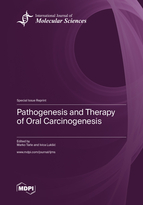Pathogenesis and Therapy of Oral Carcinogenesis
A special issue of International Journal of Molecular Sciences (ISSN 1422-0067). This special issue belongs to the section "Molecular Pathology, Diagnostics, and Therapeutics".
Deadline for manuscript submissions: closed (15 July 2023) | Viewed by 23144
Special Issue Editors
2. School of Dental Medicine, University of Zagreb, 10 000 Zagreb, Croatia
Interests: oral cancer; head and neck cancer; cancer therapy; molecular biomarkers; maxillofacial surgery
Special Issues, Collections and Topics in MDPI journals
2. School of Medicine, University of Zagreb, 10 000 Zagreb, Croatia
Interests: head & neck surgery; plastic & reconstructive surgery; neck cancer; salivary gland tumor; oral cavity carcinoma
Special Issues, Collections and Topics in MDPI journals
Special Issue Information
Dear Colleagues,
Despite the development of diagnostic and therapeutic strategies in recent decades, oral squamous cell carcinoma (OSCC) has a high morbidity and mortality (less than 50%), and represents a major challenge for scientists and clinicians. Although the oral cavity is readily accessible for clinical examination, in 2020, 377,713 people worldwide were diagnosed with lip and oral cancer, while 177,757 people died from it, with a trend toward increasing numbers of patients younger than 50 years of age. Preventive oral screening for high-risk patients and the detection, monitoring and treatment of oral potentially malignant disorders (OPMD) such as oral leukoplakia (OL) and oral erythroplakia (OE) are essential for the prevention of OSCC. New biomarkers for OPMD that indicate a high risk of malignant transformation need to be identified, and the approach to the treatment and follow-up of these patients needs to be modified, as does the development of drugs that reduce the progression of genetic changes in apparently healthy mucosa.
The shortcomings of histopathologic classification systems in predicting the malignant transformation of OPMD and the survival prognosis of patients with OSCC motivate us to explore the complex molecular pathways involved in the development of oral cavity cancer and its spread to regional lymph nodes and distant organs.
In this Special Issue, we encourage the publication of research and review articles addressing the various molecular mechanisms involved in the different steps of oral carcinogenesis that could serve as diagnostic biomarkers and therapeutic targets.
Dr. Marko Tarle
Prof. Dr. Ivica Lukšić
Guest Editors
Manuscript Submission Information
Manuscripts should be submitted online at www.mdpi.com by registering and logging in to this website. Once you are registered, click here to go to the submission form. Manuscripts can be submitted until the deadline. All submissions that pass pre-check are peer-reviewed. Accepted papers will be published continuously in the journal (as soon as accepted) and will be listed together on the special issue website. Research articles, review articles as well as short communications are invited. For planned papers, a title and short abstract (about 100 words) can be sent to the Editorial Office for announcement on this website.
Submitted manuscripts should not have been published previously, nor be under consideration for publication elsewhere (except conference proceedings papers). All manuscripts are thoroughly refereed through a single-blind peer-review process. A guide for authors and other relevant information for submission of manuscripts is available on the Instructions for Authors page. International Journal of Molecular Sciences is an international peer-reviewed open access semimonthly journal published by MDPI.
Please visit the Instructions for Authors page before submitting a manuscript. There is an Article Processing Charge (APC) for publication in this open access journal. For details about the APC please see here. Submitted papers should be well formatted and use good English. Authors may use MDPI's English editing service prior to publication or during author revisions.
Keywords
- oral cancer
- oral premalignant disorders
- tumor microenvironment
- molecular biomarkers
- targeted therapy
- oral tumorigenesis








